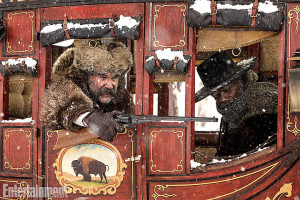At the end of 2015, The Hateful 8 barnstormed across select theaters, a whirlwind, even prior to its release, of debate. Positions were staked well in advance, and much of it came down to rather esoteric arguments about 70 mm projection and the future of film. It was the great, very white hope, and in some cinephile circles, it seemed canonized as an idea before it ever screened. To reject Quentin Tarantino’s presumptive film-saving masterpiece seemed tantamount to rejecting film itself, aligning oneself with the philistines.
This was, of course, bullshit, and remains so. Tarentino, for all his many, well-documented faults, can easily be admired for his commitment to the medium, and also rejected for the specific outcomes of that commitment. A Panavision version of your baby taking an exceedingly nasty dump IN GLORIOUS 70 MM says nothing one way or the other about the value of the film it was shot on. But it still might be rather unpleasant.
And so, with that gross metaphor, I come to the film itself. The Hateful 8 – for me, far more the paragon of hype than The Force Awakens – is dead on arrival. It’s the ultimate expression of something that’s become clear about Tarentino’s output for years: the prioritizing of style to cover an utter absence of substance, an almost pathological need to appropriate the struggles of marginalized groups and cram them uncomfortably into the exploitation trappings of the films he clearly adores, and a pretension far more nefarious than anything Alejandro Innaritu has managed to be guilty of. It’s not just a bad movie – it might be an evil one.
Why? For one thing, because of his skill. Let there be no misunderstanding: Quentin Tarentino is some kind of cinema savant. He has absorbed so many of its tropes and mechanisms that the exhilarating experience of encountering one of his more recent films utterly obliterates the total lack of meaning inside the image. He constructs a vast series of empty referents, sets them against each other, and watches them explode. Explosions are, by definition, exciting. He counts on this, and he’s savvy to do so. But once the spectacle has worn off, you are left with the sneaking suspicion that you’ve been epically cheated.
This was true in Inglorious Basterds, where he killed Hitler for us (thanks, man!). This was true in Django Unchained, where he made Blaxpoitation over in his own, revenge-fantasy image – an obsessed cinephile’s counter-history, formed far more from image-fetishism than anything like conviction. And it reaches its pinnacle in The Hateful 8, a drawing-room drama by way of The Thing and The Searchers. One main difference between the previous two and this latest installment in the Quentin Tarentino Revenge Chronicles On Other People’s Behalf is that language fails him, the least expected of failures from a Tarentino film. Having leapt down a rabbit hole of his own making, into pure images, he’s evidently at a loss of things to say at all, and so falls back on the only few words that have worked in the past. They do not work.
Drawing, as ever, on the tropes of revisionist westerns, Tarentino brings together a mix of types, all compromised and all justified in their own minds, and puts them on a collision course. One of many perversities, he deploys the epic scope of his 70 mm approach to focus on faces in a room rather than widescreen expanses, less McCabe and Ms. Miller than 12 Angry Men (And One Brutalized Woman). A bounty hunter and his prey; a Black Union soldier who may or may not have a letter from Lincoln, but he certainly has a reputation for brutality; a sheriff on his way to his post, but with a Confederate history and a grudge or two; a Confederate officer full of bile; and … some others.
As per usual, the narrative is oddly structured and turns back on itself, a trope that hasn’t seemed fresh since the avalanche of post-Pulp Fiction knockoffs a near-generation ago. The difference here is the maximalism, the total commitment to gross-out moments, and an absolute devotion to racist and misogynistic language. This, he might be saying, is the root of the America in which we find ourselves. It works better on paper.
I confess some prejudices underwriting my reaction. First, I did walk out exhilarated. It’s hard not to. A few moments actually drop jaws with the gorgeousness of the snowy, desperate images; a few genuinely shock with jump-scares more appropriate to a horror movie; a few ugly laughs are elicited. It’s a decidedly nasty film, and it knows it. This, I take it, is to its credit, according to many viewers. But the more I thought about it, the more I chalked my own reaction up to unearned good will, to the fact I wanted so much for it to move and surprise me. It didn’t – it steamrolled me, which is not the same thing.
On top of that, it is perhaps unfair to judge a movie based on its audience, but watching The Hateful 8 in the theater was one of the most uncomfortable experiences I can remember at the movies. A nearly uniformly white, male audience belly-laughed at each use of the word “nigger,” as though that were a joke in and of itself, and doubled-over every time Jennifer Jason Leigh was punched in her face. What was so funny? Why was this generating so much laughter?
I’d like to think it’s because they were uncomfortable too, and we often respond to discomfort with laughter. But there wasn’t much nervousness there. It was what they came to see. They were the same guys with Travis Bickle posters on their dorm-room walls, who waited with baited breath for the “transgressive” moments in any low-budget film where women were abused. It’s not a bug, as they say; it’s a feature.
None of which would matter, or would matter a lot less, if the film delivered on its revisionist promises. It doesn’t, and manages to be both hyper-excited and under-cooked. It’s image as pure fetish, and scandalousness as spectacle. There’s a temptation to find in its final shot a metaphor for a west giving way to uneasy alliances, unified over particular brutality, but there’s little reason to think that’s anything but a hopeful reading of a hopeless film, more in love with itself than animated by anything else at all.
Quentin Tarentino is a master of form and style, and not everyone who admires him falls into the bro-camp of nasty gigglers who watched it with me. But he’s also a filmmaker with nothing left to say, as far as I can tell. Film 10 can’t come soon enough. Maybe he has a book in him.




